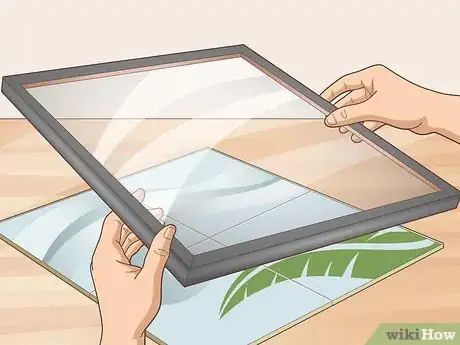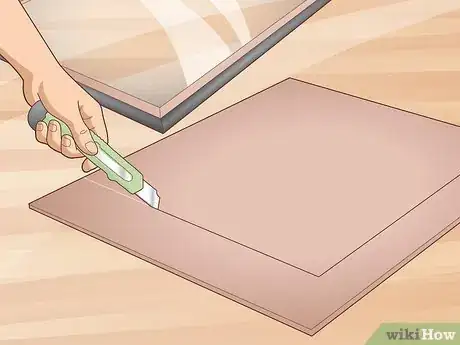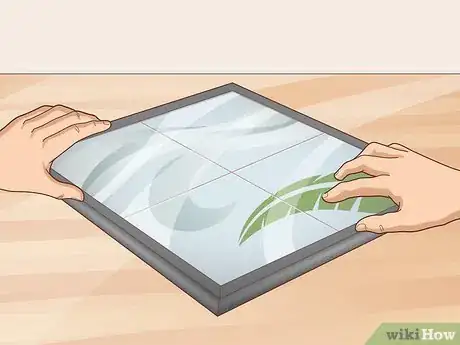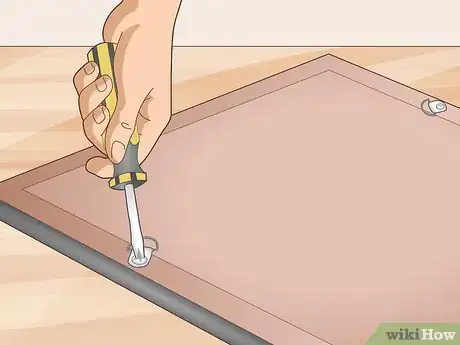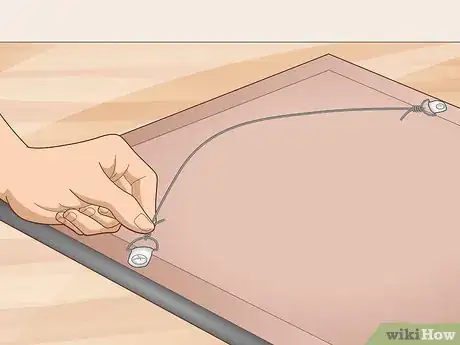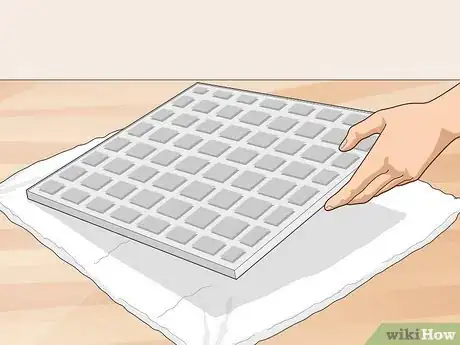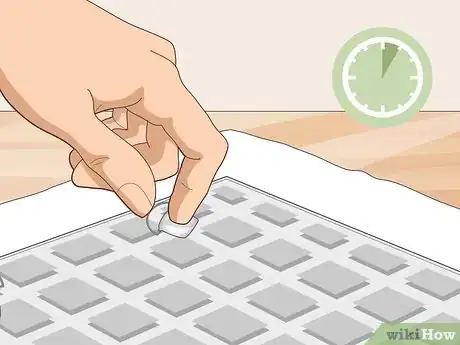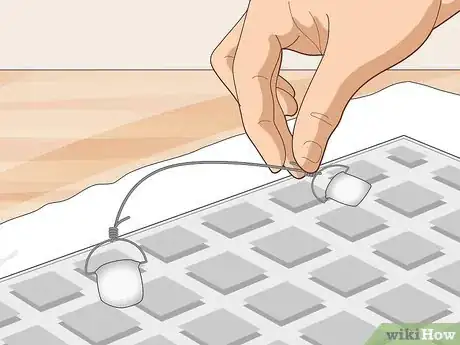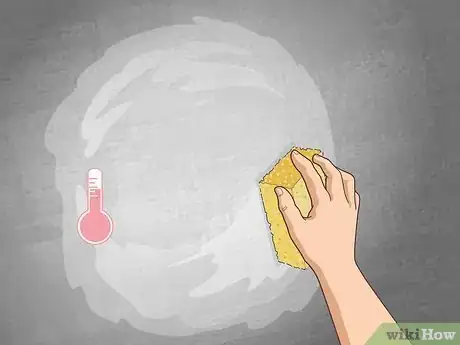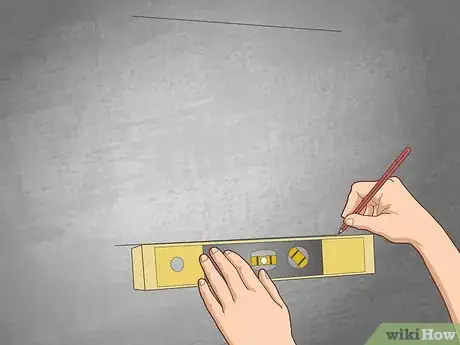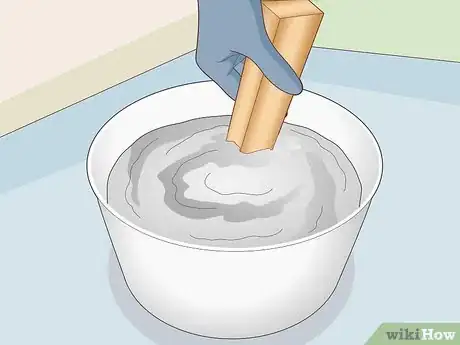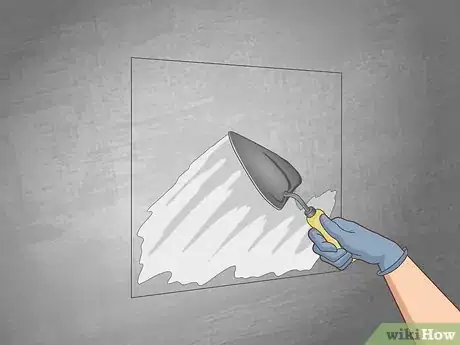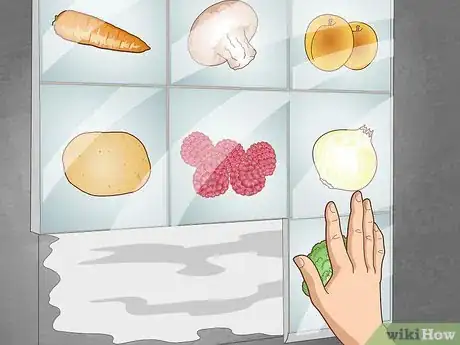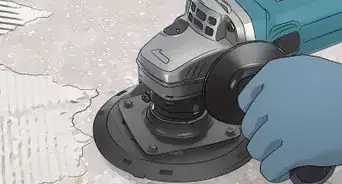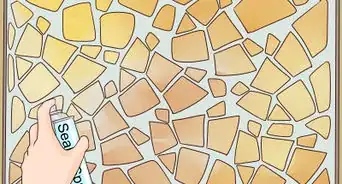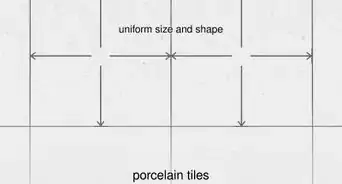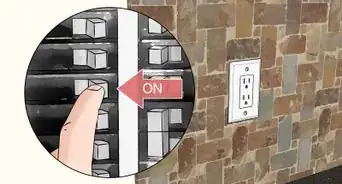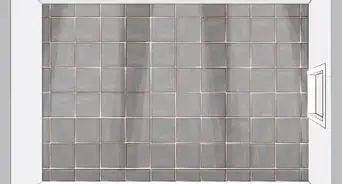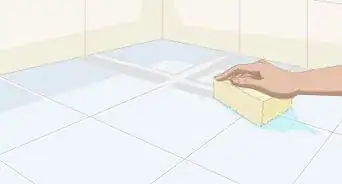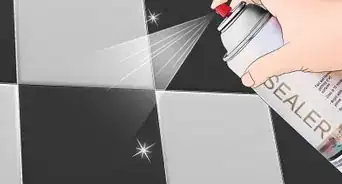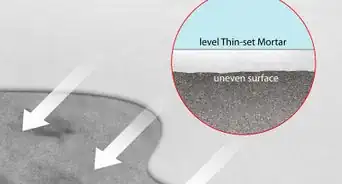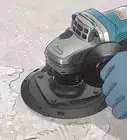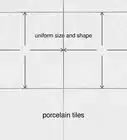This article was co-authored by Ryaan Tuttle. Ryaan Tuttle is a Home Improvement Specialist and the CEO of Best Handyman, Inc. in Boston, Massachusetts. With over 17 years of experience, he specializes in building home service businesses, focusing on creating scalable and efficient brands. With the help of his global team, the companies have achieved over 10+ million in sales and received recognition through magazine features, and enjoy partnerships with wikiHow and Jobber field service software. Boston Magazine and LocalBest.com have named Best Handyman Boston the Best Handyman in Boston. Ryaan holds Construction Supervisor and Home Improvement Contractor Licenses.
There are 18 references cited in this article, which can be found at the bottom of the page.
This article has been viewed 43,465 times.
Because tiles add such a unique and colorful dynamic to a room, they are a favorite canvas for many artists. However, they are also fragile and prone to damage if they aren’t hung with care. If you’re looking for maximum protection, set tile inside of a frame and hang it like any other piece of art. Bare tile is a little more difficult to put up, but you could glue some hangers on the back and run picture wire between them. Tile can also be secured directly to a surface with mortar and grout for long-term display or wall protection. Whether you purchased tile art, made a piece yourself, or are simply covering a surface, you can find a way to fit tiles on a wall.
Steps
Framing Tile
-
1Use a tape measure to measure the size of the tiles. Set the tiles down on a flat surface. If you’re concerned about damaging them, spread out a clean towel or blanket first. Then, take the length and width of each tile you plan on hanging. Write down these measurements so you can use them to get a suitable frame.[1]
- If you’re planning on including several tiles in a single frame, such as for a mosaic, arrange them side by side. Then, measure them as a whole instead of individually.
-
2Select a picture frame that is big enough for the tile. Try to find a picture frame matching the size of your tile. There are some designed specifically for ceramic tiles. They typically have a strong backing and pre-fitted hanging hooks. Shadow boxes, which are glass-fronted cases, are also strong and deep enough to hold tiles.[2]
- Check online or at art supply stores for a selection of picture frames. If you have a framing service in your area, look into it for more options. Other places, including general and secondhand stores, also may carry some quality frames.
- If you’re unable to find a frame you like, you could make a frame or a shadow box by cutting wood and a strong backing. Finding a pre-made frame, especially for large mosaics, can be tough.
Advertisement -
3Cut backer board if the frame doesn’t have its own backing. If you’re making your own backing, choose a lightweight but damage-resistant material like backer board. Measure out the backer board according to the size of the frame, marking an outline in pencil. Then, cut along the outline using a sharp utility knife or a scoring tool. Check to see if the cut board fits well inside the frame and trim it if it needs a little more adjustment.[3]
- Store-bought frames often come with cardboard backing. It tends to be thin and prone to crumbling underneath heavy tiles. Use something designed for tile, like backerboard, if the frame’s cardboard seems flimsy.
- Cork and plywood are some other materials you could try. Medium-density fiberboard and thick cardboard also work well in most cases.
- The supplies you need for the backing are available online and at most hardware stores.
-
4Use an industrial-strength glue to secure the tile to the backing. Flip the tile so it’s facedown, but leave the backing face up. The glue comes in a squeeze bottle, so it’s easy to apply in neat lines. Start with the backing, spreading a line about 1 in (2.5 cm) from its edges. Then, apply a separate line of glue along the edges of the tile. Press the tile firmly onto the backing board to secure them together.[4]
- The glue is very strong and sticky. Once it gets on your hands, it is difficult to wash off, so only handle it while wearing rubber gloves.
-
5Assemble the picture frame after the glue has had a chance to dry. The glue can take a while to dry, so leave the tile alone for at least 24 hours. Keep it in a spot with good air circulation so it dries faster. Once the tile feels completely stuck to the backer board, fit the board into the picture frame. Put the frame's glass cover on top of the tile if it has one.[5]
- Check the manufacturer’s recommendations to ensure you give the glue enough time to dry. Some products may take as long as 72 hours to fully cure!
-
6Screw a pair of metal hangers onto the back of the frame. A traditional way to hang framed art is with a tool called a metal d-ring. Choose d-rings that have a tab with a screw hole in the middle. Position each one about ¼ of the way down from the top of the frame. Then, use the included screws and an electrical screwdriver to secure them directly to the frame.[6]
- The rings can be positioned so they are point straight up or at a diagonal angle toward the frame’s interior. No matter what, make sure they are set at the same angle so the frame doesn’t look crooked on the wall.
- You could also glue the d-ring tabs to the frame or backer board. Another option is to get a traditional metal hanger and glue it to the tile or frame.
- D-rings tend to come with screws about 1⁄4 in (0.64 cm) in size, but this can vary depending on the hanger size. If you need a new screw, check the size of the screw hole.
-
7Tie a steel hanging wire to the d-rings. Get a galvanized hanging wire, since it’s strong enough to support most projects. Stretch it out between the d-rings, leaving about 1 in (2.5 cm) of extra length on both ends. Then, snip the wire to size with a pair of pliers or wire cutters. Loop the wire around both d-rings and knot it in place to finish preparing the tile for hanging.[7]
- You could also use picture wire, but save it for smaller projects. For example, use it for coaster-sized tiles. It may not be able to support bigger, heavier tiles.
-
8Hang the picture by attaching a metal hanger to the wall. Select a z-shaped nail-on picture hanger. Position it on the wall with the hook end on the bottom. Then, use a hammer to pound the included nail through the hole on the top end. Place the picture wire onto the hook to finish hanging the tile.[8]
- To ensure your tile doesn’t end up on the ground, make sure the hanger is positioned on a wall stud. Locate them with a stud finder that beeps as it passes over them.
- There are other types of wall hangers that may work as well. For example, you could get a wall cleat. Half of the cleat fits on the wall while the other half fits on the frame. Slide the frame onto the wall cleat to hang it.
Attaching Hangers to Unframed Tile
-
1Place the tile facedown on a soft, clean towel. Take care to avoid scratching or damaging the tile while you’re attaching hangers to it. Keep it on a flat, stable surface while you work. Also, avoid pressing down too hard on it.[9]
- You could also use a blanket, paper towel, or another clean surface that won’t damage the tile.
-
2Position a pair of hanging rings about 1⁄4 in (0.64 cm) of the way down the tile. Get metal d-rings with screw-on tabs for a simple but efficient way to hang the tile. Set them on the back of the tile, about 2 in (5.1 cm) from the tile’s side edges. Set the rings so the screw-on tab is on the bottom with the ring above it. Make sure the rings are spaced evenly and set at the same angle.[10]
- Try rotating the rings so they are oriented diagonally. Make them point toward the midpoint of the tile’s top edge. It makes the hanging wire easier to secure later.
-
3Apply an industrial-strength glue over the screw-on tabs. Industrial-strength glues are strong and capable of bonding metal to tile. Once you have a strong glue, pick up the d-rings and spread a small dab of glue on their undersides. Press them firmly down onto the tile to stick them in place. Then, spread more glue around the edges of the tabs and inside the screw holes for additional security.[11]
- Polyurethane super glues are also effective. You could also try a PVA glue. Check your local art supply store or hardware store for options.
- Each individual tile requires separate hangers. If you’re making a mosaic, consider gluing the tiles to a backboard instead, then attaching the hangers to it.
-
4Press the hangers down about every 5 minutes until the glue dries. Expect the glue to expand as it dries. Since that causes the hangers to separate from the frame, you have to push them back down. The glue takes about 30 minutes to dry, so stay on the ball with it. Press them down with firm amount of pressure, then use a small screw or a similar tool to smooth out any glue on top of the hangers.[12]
- Note that the drying time can vary a lot depending on the product you are using. Check the manufacturer’s recommendations. If you’re unsure, leave the tile in an area with good air circulation for 24 to 72 hours.
- Make sure the hangers are flat against the tile and well-secured so they don’t come loose later. If they feel loose, pull them off, scrape away the dried glue, then reattach them.
-
5Tie a metal hanging wire between the hangers. Use a galvanized metal wire to ensure the hangers are able to support the weight of the tile. Stretch the wire across the back of the tile, tucking the ends through the d-ring loops. Leave the wire about 1 in (2.5 cm) longer on each side than you think you need it to be, then cut it with pliers. Knot it on the rings to create a tight wire hanger for your wall.[13]
- If you’re hanging up a small tile, you could use picture wire instead. Tile tends to be heavier than other types of art, so, if you’re unsure about what to use, get galvanized wire instead.
-
6Hang the tile using a wall hook or another fastener. The easiest way to hang a tile is by securing the wire to a z-shaped wall hook. Set it on the wall with the hook end on the bottom, then nail it in place. Set the wire on the hook to suspend the tile. Make adjustments as needed to straighten out the tile and make it a pleasing part of your room decor.[14]
- For alternatives, you may be able to drill holes through the tile to string the wire if it doesn’t ruin the artwork. You could glue wall hooks onto the tile as well, or use adhesive strips for lighter pieces.
Securing Tiles With Mortar
-
1Wash the wall clean with a sponge and warm water. Any debris left on the wall could prevent the tile from adhering, so make sure you get all of it. Scrub the entire wall from top to bottom. Tackle tougher stains by mixing about 1 teaspoon (4.9 mL) of a liquid dish detergent into 4 cups (950 mL) of warm water. After you’re done cleaning, rinse and dry the wall with a clean cloth.[15]
- Vinegar and baking soda are a couple of household items that can be mixed into warm water in place of dish soap.
- For heavy-duty grease stains you can’t get out any other way, try using diluted ammonia or trisodium phosphate. These cleaners are strong, so ventilate the room and wear protective gear, including rubber gloves and a dust mask.
- Note that loose paint and other debris has to be scraped off the wall. Remove old wallpaper, tile, or other obstacles, then patch holes with spackle.
-
2Outline the area on the wall where you plan on hanging the tile. Check the size of the tile you intend on hanging and make sure you have plenty of room for it. To start, use a level to trace a line indicating where the top edge of the tile will be. Hold the level flat, then draw across the wall with chalk or a pencil. Draw a second line for the bottom edge, followed by vertical connecting lines.[16]
- Levels used at home generally have a liquid capsule with a bubble in it. When the level is positioned correctly, the bubble will be in the center of the capsule. Make sure the lines are level, or else the tiles will be crooked later!
-
3Cut the tiles to size so they fit over the wall space. If you’re hanging multiple tiles, such as for a kitchen backsplash, they may not fit perfectly when you first get them. Measure the tiles and hold them up to the guidelines you marked first. Then, use a tile cutter to quickly trim large tiles to the correct size. Tile cutters have a handle, and, when you pull the handle down, it drops a blade through the tile.[17]
- Remember to leave a gap between neighboring tiles. Plan on creating about 1⁄16 in (0.16 cm) of space for grout. Adjust your measurements accordingly!
- Check with your local hardware store to see if they rent out tile cutters. They may also be able to cut the tiles to size for you.
-
4Mix a waterproof, thinset mortar in a plastic bucket. Put on rubber gloves and a respirator mask before beginning. Start by filling the bucket with about 24 cups (5.7 L) of lukewarm water. Pour in a 50 lb (23 kg) bag of thinset mortar next. Stir the mortar with a paddle until it reaches the consistency of a thick peanut butter.[18]
- Adjust the amount of mortar and water used according to how much thinset you need. Then, thicken the mixture by adding more mortar or thin it by adding more water to bring it to the right consistency.
- You could use mastic instead. Mastic is a water-resistant acrylic glue that many installers like using for wall-hung tiles, but it doesn’t work in high-moisture areas.
- There are premixed mortars and mastics you can buy if you don’t want to deal with mixing your own thinset. These products work well with less of the mess from mixing fresh mortar.
-
5Spread the mortar on the wall with a trowel. Dip the trowel into the bucket to pick up some of the mortar. While following the guidelines you drew, wipe the mortar horizontally across the wall. Hold the trowel at a slight angle so its edge scrapes through the mortar, thinning it out. Continue spreading mortar horizontally across the uncovered portions of the wall.[19]
- Apply the mortar so it’s thicker than the tiles you’re hanging. A1⁄4 in (0.64 cm) layer is perfect for most projects.
- Before letting the mortar dry, make sure it is even and consistent across the wall. Go back and fill in any spots you missed the first time.
-
6Press the tile into the mortar to secure it to the wall. If you are able to, start with the center part of the wall. Arrange the tiles from one side of the outline to the other. To apply each tile, twist it slightly while pushing it into the mortar. After finishing the center rows, gradually fill in the remaining space.[20]
- Take a step back and look at the tile before the mortar has a chance to dry. If you’re installing multiple tiles, make sure they are all placed neatly and have been spaced out consistently.
-
7Allow the mortar to dry for up to 24 hours. Give it plenty of time to solidify so the tile doesn’t fall right back off the wall. The mortar will harden over time. You can test it by touching it or trying to move a tile.
- Check the manufacturer’s recommendations for a specific drying time. It could vary depending on the product used.
-
8Mix and apply grout between each tile. Grout is sold as a powder that has to be mixed in water. After mixing it, scoop some of it out of the bucket with a grout float or another blunt tool. Push it into the gaps between adjacent tiles to fill them. Then, wipe off excess grout on the tile with a sponge lightly dampened in water.[21]
- The ratio for mixing grout and water is usually 1 to 1, but check the manufacturer’s instructions to make sure. Combine equal amounts of grout and water to form a spreadable paste.
-
9Wait up to 24 hours for the grout to dry. Avoid getting the grout wet until then. It can still absorb moisture, which ruins the finish. In the meantime, keep air circulating throughout the room. Open up nearby doors and windows or turn on fans if you are able to.
- The grout isn’t waterproof until you apply a sealer to it. Unsealed grout is prone to mildew growth, so finish it as soon as you are able to.[22]
-
10Apply a grout sealer to finish waterproofing the tile. Grout sealers come in a spray-on or wax variety. For the spray-on variety, hold the nozzle about 6 in (15 cm) from the wall. Starting at the top, spray all of the grout to saturate it. If you’re using a wax type of sealer, spread it onto the grout with a sponge or brush applicator. After an hour, apply a second coating of the sealer to finish the installation.[23]
- You may come across penetrating and membrane-forming sealers. Get a penetrating sealer to prevent mildew, especially in high-moisture areas like the bathroom.
- Be sure to wipe off excess sealer before it has a chance to dry. Scrub it off of tile with a dry cloth. It starts drying after about 5 minutes and is tough to remove after that.
Expert Q&A
-
QuestionHow can you remove grout?
 Ryaan TuttleRyaan Tuttle is a Home Improvement Specialist and the CEO of Best Handyman, Inc. in Boston, Massachusetts. With over 17 years of experience, he specializes in building home service businesses, focusing on creating scalable and efficient brands. With the help of his global team, the companies have achieved over 10+ million in sales and received recognition through magazine features, and enjoy partnerships with wikiHow and Jobber field service software. Boston Magazine and LocalBest.com have named Best Handyman Boston the Best Handyman in Boston. Ryaan holds Construction Supervisor and Home Improvement Contractor Licenses.
Ryaan TuttleRyaan Tuttle is a Home Improvement Specialist and the CEO of Best Handyman, Inc. in Boston, Massachusetts. With over 17 years of experience, he specializes in building home service businesses, focusing on creating scalable and efficient brands. With the help of his global team, the companies have achieved over 10+ million in sales and received recognition through magazine features, and enjoy partnerships with wikiHow and Jobber field service software. Boston Magazine and LocalBest.com have named Best Handyman Boston the Best Handyman in Boston. Ryaan holds Construction Supervisor and Home Improvement Contractor Licenses.
Home Improvement Specialist You can use a Dremel tool. It's an awesome tool for grout removal. They have a special grout bit attachment.
You can use a Dremel tool. It's an awesome tool for grout removal. They have a special grout bit attachment. -
QuestionHow could you whiten dirty grout?
 Ryaan TuttleRyaan Tuttle is a Home Improvement Specialist and the CEO of Best Handyman, Inc. in Boston, Massachusetts. With over 17 years of experience, he specializes in building home service businesses, focusing on creating scalable and efficient brands. With the help of his global team, the companies have achieved over 10+ million in sales and received recognition through magazine features, and enjoy partnerships with wikiHow and Jobber field service software. Boston Magazine and LocalBest.com have named Best Handyman Boston the Best Handyman in Boston. Ryaan holds Construction Supervisor and Home Improvement Contractor Licenses.
Ryaan TuttleRyaan Tuttle is a Home Improvement Specialist and the CEO of Best Handyman, Inc. in Boston, Massachusetts. With over 17 years of experience, he specializes in building home service businesses, focusing on creating scalable and efficient brands. With the help of his global team, the companies have achieved over 10+ million in sales and received recognition through magazine features, and enjoy partnerships with wikiHow and Jobber field service software. Boston Magazine and LocalBest.com have named Best Handyman Boston the Best Handyman in Boston. Ryaan holds Construction Supervisor and Home Improvement Contractor Licenses.
Home Improvement Specialist They make these cool grout pens. It's like a paint marker that's designed to paint the grout lines. Instead of re-grouting an entire floor, you can buy a white grout pen, and go over all the grout lines. One tip is depending on what type of tile you're going to do, you may want to use some painter's tape or blue masking tape and tape off the grout lines.
They make these cool grout pens. It's like a paint marker that's designed to paint the grout lines. Instead of re-grouting an entire floor, you can buy a white grout pen, and go over all the grout lines. One tip is depending on what type of tile you're going to do, you may want to use some painter's tape or blue masking tape and tape off the grout lines.
Warnings
- Mortar, grout, and some cleaners produce irritating fumes that are harmful to breathe in. In addition to ventilating the room, always wear rubber gloves and a dust mask when using these products.⧼thumbs_response⧽
Things You’ll Need
Framing Tile
- Wood picture frame
- Backer board, plywood, or cork backing
- Industrial-strength glue
- D-ring hangers
- Screws
- Cordless screwdriver
- Hanging hook
- Galvanized steel hanging wire
- Pliers
Attaching Hangers to Unframed Tile
- D-ring hangers
- Industrial-strength glue
- Galvanized steel hanging wire
- Pliers
- Hanging hook
Securing Tiles With Mortar
- Tile
- Tile cutter
- Measuring tape
- Pencil or chalk
- Thinset mortar or mastic
- Grout
- Trowel
- Water
- Dish soap
- Clean rags
- Mixing bucket
- Mixing paddle
- Dust mask
- Rubber gloves
References
- ↑ https://www.youtube.com/watch?v=WtbNBnWTV8Q&feature=youtu.be&t=96
- ↑ https://www.youtube.com/watch?v=oVwgWGIq5zw&feature=youtu.be&t=92
- ↑ https://www.youtube.com/watch?v=H0M26sg1z4c&feature=youtu.be&t=299
- ↑ https://www.youtube.com/watch?v=H0M26sg1z4c&feature=youtu.be&t=373
- ↑ https://www.youtube.com/watch?v=iKDmd_faFyU&feature=youtu.be&t=535
- ↑ https://www.youtube.com/watch?v=WtbNBnWTV8Q&feature=youtu.be&t=233
- ↑ https://www.youtube.com/watch?v=mdU0B8ov2Z0&feature=youtu.be&t=121
- ↑ https://www.bobvila.com/articles/picture-hanging-tips/
- ↑ https://www.youtube.com/watch?v=6UynP-rZksc&feature=youtu.be&t=250
- ↑ https://www.youtube.com/watch?v=6UynP-rZksc&feature=youtu.be&t=460
- ↑ https://www.youtube.com/watch?v=6UynP-rZksc&feature=youtu.be&t=433
- ↑ https://www.youtube.com/watch?v=6UynP-rZksc&feature=youtu.be&t=460
- ↑ https://www.youtube.com/watch?v=xnr5a3NLqh0&feature=youtu.be&t=308
- ↑ https://www.youtube.com/watch?v=UhKSWiegLdE&feature=youtu.be&t=224
- ↑ https://www.thisoldhouse.com/how-to/how-to-install-simple-tile-backsplash
- ↑ https://www.thisoldhouse.com/how-to/how-to-install-simple-tile-backsplash
- ↑ https://www.bobvila.com/articles/2327-how-to-install-ceramic-tile/
- ↑ https://www.thisoldhouse.com/how-to/how-to-install-tile-backsplash
- ↑ https://www.thisoldhouse.com/how-to/how-to-install-tile-backsplash
- ↑ https://www.bobvila.com/articles/2327-how-to-install-ceramic-tile/
- ↑ https://www.bobvila.com/articles/how-to-mix-grout/
- ↑ https://www.bobvila.com/articles/how-to-seal-grout/
- ↑ https://www.bobvila.com/articles/how-to-seal-grout/

